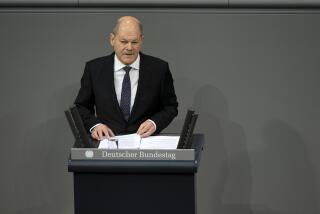Germany’s Short-Term Difficulties Dwarfed by Long-Range Problems
- Share via
The German economy continues to slump. At a time when many Europeans look to Germany to lead their economies toward unification with higher growth and low inflation, Germany seems headed toward lower growth and higher inflation. Germany’s recession is deeper and has lasted longer than many expected only a few months ago.
Inflation has remained about 4% to 4.5% for the last two years. Standard opinion describes monetary policy as restrictive or “tight” because the Bundesbank has been slow to reduce short-term interest rates during the recession.
This interpretation is mistaken.
The Bundesbank continued to pump out reserves and money in 1992 in part because the bank was called upon to support the French franc and other currencies last fall. Whatever the reason, growth of reserves and money has remained far above the rate required for a permanent reduction in inflation.
Severe as they are, Germany’s short-term difficulties seem less serious than its longer-term problems.
When the current recession ends, two major problems will remain.
First, the mark is overvalued, so German goods and services cost much more than competing foreign products. Second, the cost problem was not solved by shifting to low-cost production in the new states of eastern Germany.
Instead, German producers have agreed to wage increases--and promised future wage increases--that far exceed any likely productivity gain in the east. Production costs in eastern Germany are now far above costs in western Germany. There is no reason to build or modernize plants.
Since the worldwide Reagan-era boom ended early in 1985, costs of production in western Germany have increased about 33%. Most of the rise came in the last five years.
During the same period, U.S. production costs rose less than 5% and Japanese costs increased at about half the German rate. As a result, Germany’s competitive position has declined in the United States and Japan, as well as in countries where they all compete.
Germany can regain its competitiveness by depreciating the mark against the dollar and the yen, as is beginning to happen. Also, individual companies can lower costs by shifting production out of Germany. The recent announcements by BMW and Mercedes-Benz that they will produce cars in the United States is part of a continuing move of German producers to foreign markets. These decisions suggest that producers view the problem as long-term and structural.
Decisions to relocate production abroad solve some of Germany’s problems, but the short-term effect at home is reduced demand for labor and higher unemployment.
In Germany’s costly welfare state, unemployed workers receive substantial benefits that are paid for by taxing wages and incomes. These taxes are a main reason why production costs are comparatively high and slow to decline and why unemployment persists. The taxes not only raise the costs of hiring labor but also pay for the high level of benefits that reduce incentives for unemployed workers to accept jobs at lower wages.
Three years ago, I described German economic policy as “Reaganomics on the Rhine.” That description highlighted some important similarities between German economic policy at the time of unification and the early Reagan policies.
Both countries lowered inflation by reducing money growth. In both countries, interest rates rose, the currency appreciated and there were large budget deficits. Output rose. The analogy looked good.
Reagan’s policies sustained prosperity and growth for a decade--the longest peacetime expansion in U.S. history. German policies changed in ways that I did not foresee and ended in recession.
First, the government has been slow to settle property ownership claims in the former East Germany. Germany allowed claims and counterclaims to slow the spread of private ownership.
Second, employers promised wage increases that would bring parity with workers in western Germany within a few years. It is now even costlier to produce many goods in the east than in western Germany. Aside from trade and construction--much of the latter financed by government--not much is happening in eastern Germany.
Third, Germany’s fixed exchange rate against its European trading partners hinders correction of past mistakes. Several of these partners recently devalued against Germany, adding to Germany’s problem as a high-cost producer.
The German recession may end in 1994, as many forecasters predict. The long-term problem will remain. A weak German economy cannot lead Europe to high growth or unification.
More to Read
Inside the business of entertainment
The Wide Shot brings you news, analysis and insights on everything from streaming wars to production — and what it all means for the future.
You may occasionally receive promotional content from the Los Angeles Times.










